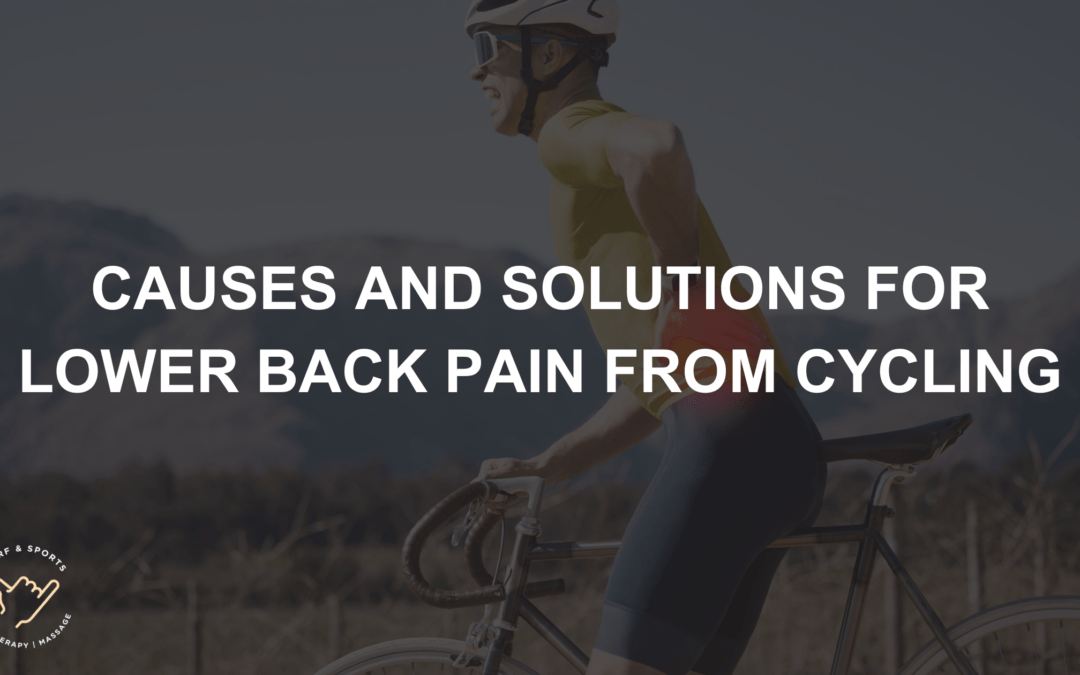Cycling is a fantastic way to stay fit, but it can sometimes lead to lower back pain, especially with improper posture or bike setup. Understanding the root causes of your discomfort is the first step to resolving it.
This guide will help you identify common causes of lower back pain from cycling and offer solutions to ensure a pain-free ride, allowing you to enjoy cycling while protecting your back.
Key Takeaways:
- Proper Bike Fit: Adjust your bike to your body’s dimensions to reduce back strain.
- Core Strength: Strengthening your core provides support for your lower back during rides.
- Stretching and Recovery: Regular stretching before and after rides relieves tension and prevents pain.
Common Causes of Lower Back Pain in Cyclists
Lower back pain in cyclists often stems from three main factors: poor bike fit, weak core muscles, and inadequate flexibility.
1. Poor Bike Fit
If your bike isn’t properly adjusted to your body, you’re likely to strain your lower back.
An incorrect saddle height, handlebar position, or bike frame size can force you into awkward postures, leading to discomfort. Road and mountain biking can affect your back differently, so it’s worth knowing how each style impacts you. Here’s a guide on low back pain in cycling that explains these differences.
A professional bike fit is essential to avoid these issues.
2. Weak Core Muscles
Your core muscles—those in your abdomen and lower back—help stabilize your spine during cycling. If these muscles are weak, your back takes on more strain to support your body, which can lead to pain. Strengthening your core is crucial for stability and proper posture.
3. Inadequate Flexibility
Tight muscles in the hamstrings, hips, or lower back can limit your range of motion and force you into unnatural cycling positions. This tension can contribute to lower back pain, particularly during long rides.
Identifying Symptoms of Lower Back Pain
Common symptoms of lower back pain from cycling include:
- Dull ache in the lower back.
- Sharp, stabbing pain during or after rides.
- Muscle spasms in the back.
- Pain radiating into the legs or buttocks.
If your pain persists or worsens, or if you experience numbness or weakness in your legs, consult a healthcare professional to rule out serious conditions like a herniated disc.
Preventative Measures
Preventing lower back pain starts with proper preparation. Here are some key strategies to keep your back pain-free while cycling
1. Proper Bike Setup
Adjust your bike to match your body’s dimensions. Ensure your seat is at the right height—your leg should be nearly straight when the pedal is at its lowest point.
Position the handlebars so you’re not overreaching or hunching over.
This helps you maintain proper posture and reduces strain on your lower back.
2. Stretching and Strengthening Exercises
Incorporate stretching and core-strengthening exercises into your routine to support your back. Simple stretches like hamstring, hip flexor, and lower back stretches can improve flexibility. Strengthen your core with exercises like planks, bridges, and back extensions to enhance stability and protect your spine.
3. Posture and Cycling Technique
While riding, focus on maintaining a neutral spine and engaging your core.
Keep your back straight and avoid hunching over the handlebars. Adjust your position during longer rides to relieve tension and keep your muscles relaxed.
Treatment Options
If you’re already experiencing lower back pain from cycling, there are several treatment options to help alleviate the discomfort:
1. Physical Therapy
A physical therapist can assess your posture and movement patterns, providing exercises to strengthen weak areas and improve flexibility. Therapy helps target the root cause of your pain, promoting recovery and preventing future issues.
2. Pain Relief Methods
Over-the-counter pain relievers, such as ibuprofen, can help reduce inflammation and ease discomfort. Heat therapy, like a warm compress, can soothe muscle tension before a ride, while ice packs can reduce swelling afterward.
3. Cycling Technique Adjustments
Small adjustments in your cycling technique can make a big difference in comfort.
Maintain a smooth, even pedal stroke and choose gears that allow for a steady cadence without straining your back. On steep climbs, switch to lower gears to reduce the load on your spine.
Long-Term Solutions
For long-term relief and prevention of lower back pain, consider these strategies
1. Regular Fitness Routine
Incorporate strength training and flexibility exercises into your weekly routine to build a strong, supportive core. Activities like yoga can improve both your strength and flexibility, helping you maintain a proper cycling posture.
2. Ergonomic Adjustments
Ensure your bike setup is optimal for your body’s dimensions. A professional bike fitting can make a significant difference in comfort, preventing unnecessary strain on your back.
Consider ergonomic upgrades, like padded shorts or cushioned grips, for added comfort.
Conclusion
Lower back pain from cycling is often caused by poor bike fit, weak core muscles, or inadequate flexibility. We can help you make adjustments to your bike, improve your posture, and incorporate core-strengthening exercises into your routine. These small changes can significantly enhance your cycling experience, allowing you to enjoy longer, pain-free rides.
Experiencing lower back pain from cycling? Our team at Surf and Sports Myotherapy specializes in personalized treatment and preventative solutions for cyclists. Book a session today to address the root causes of your discomfort and get back to enjoying a pain-free ride!

